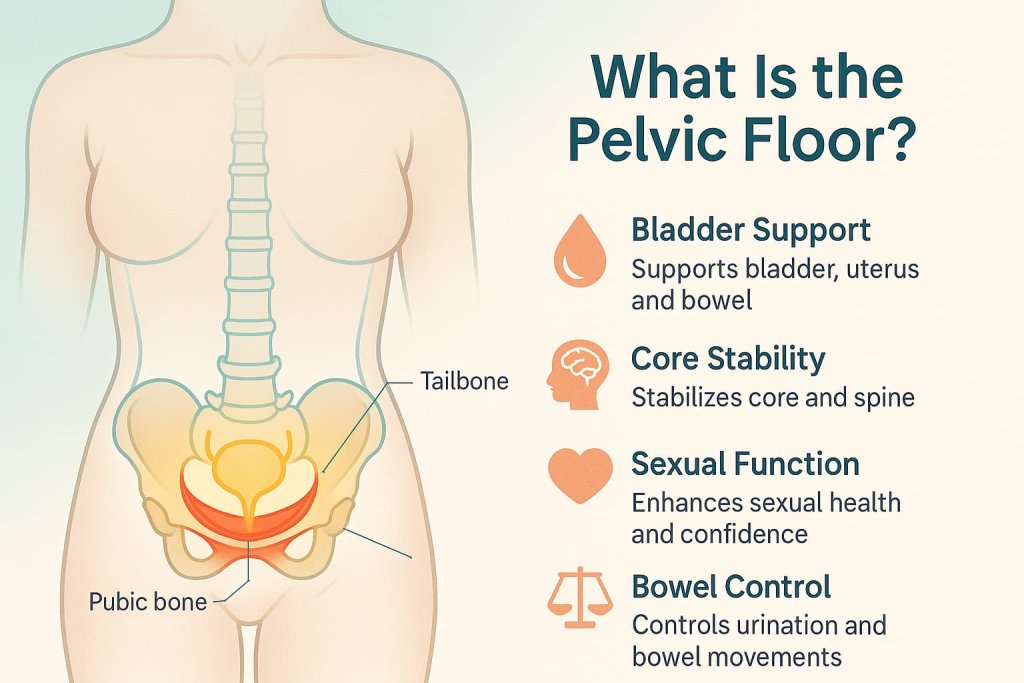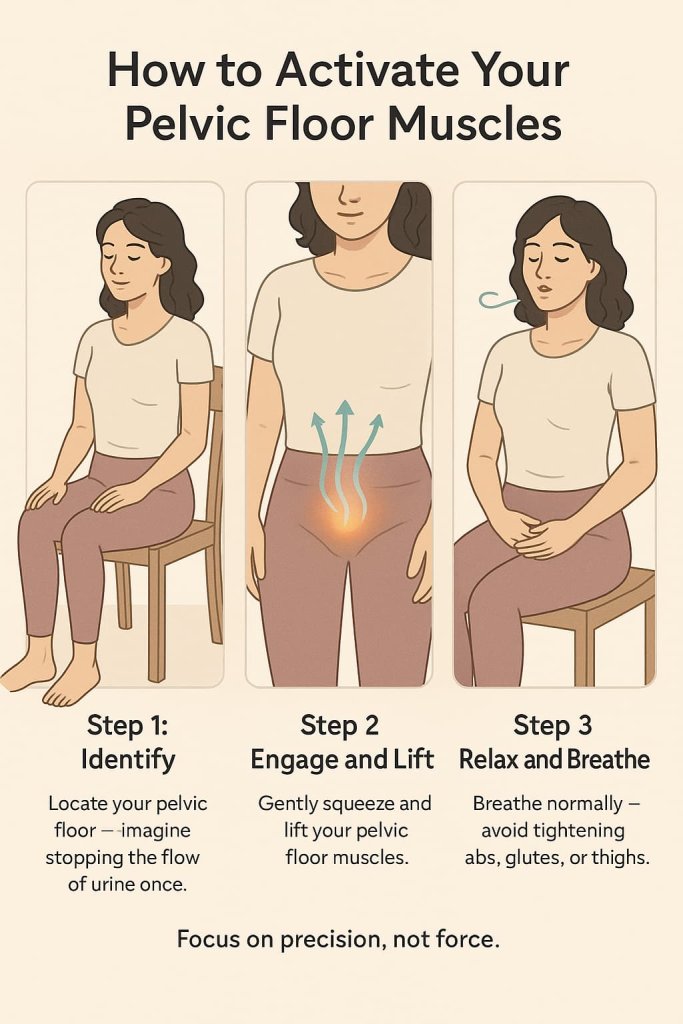Pelvic floor exercises are the most effective way to strengthen the muscles that support your bladder, bowel, and core stability. These movements—commonly known as Kegels—help prevent leaks, improve posture, and boost confidence.

Understanding your pelvic floor is essential because it plays a key role in bladder control, sexual health, and lower-back stability. Whether you’re postpartum, approaching menopause, or simply want better core control, these exercises can make a measurable difference.
According to a 2024 BMC Women’s Health study, 12 weeks of structured pelvic-floor muscle training improved urinary control and quality of life by more than 60%. That means with consistency and correct technique, results are both visible and sustainable.
What Is the Pelvic Floor?

The pelvic floor is a group of muscles and ligaments that stretch like a hammock from your pubic bone to your tailbone. These muscles:
- Support the bladder, uterus, and bowel
- Control the release of urine and stool
- Stabilize your spine and core
- Enhance sexual sensation and function
When these muscles weaken—from pregnancy, childbirth, heavy lifting, or aging—you may notice leaks, pelvic pressure, or reduced core stability. Strengthening the pelvic floor restores control, improves balance, and supports your overall posture.
How to Activate Your Pelvic Floor Muscles

Before beginning, identify the correct muscles:
- While urinating, try to stop the flow mid-stream (only once, for awareness).
- Feel the gentle internal “lift”—that’s your pelvic floor.
- Avoid tightening your abs, buttocks, or thighs.
- Once identified, practice contracting those muscles while breathing normally.
Focus on precision, not force. A correct contraction should feel like an inward and upward lift.
12 Best Pelvic Floor Exercises
Each move below helps strengthen, support, and coordinate your pelvic floor.
1. Kegel Contractions
Why it works:
The foundation of all pelvic-floor training, Kegel contractions directly strengthen the muscles that support the bladder, uterus, and bowel. They improve urinary control, enhance core stability, and promote better sexual function.
Muscles worked:
Pelvic diaphragm (levator ani group), urethral sphincter, and deep core stabilizers.
How to do it:
- Sit or lie comfortably with your spine neutral.
- Tighten your pelvic muscles as if you’re stopping urine flow.
- Hold for 5 seconds, then relax for 5 seconds.
- Perform 10–15 reps, twice daily.
Trainer Tip:
Focus on gentle internal lifting, not squeezing your abs or glutes. Breathe steadily—never hold your breath.
2. Bridge Pose
Why it works:
The bridge pose engages the glutes and pelvic floor together, strengthening both the posterior chain and core stabilizers for enhanced hip and bladder support.
Muscles worked:
Gluteus maximus, hamstrings, lower back, and pelvic floor muscles.
How to do it:
- Lie on your back, knees bent, feet hip-width apart.
- Press your heels into the floor and lift your hips.
- Squeeze glutes and engage the pelvic floor at the top.
- Hold for 5 seconds and lower slowly.
Trainer Tip:
Avoid arching your lower back. Keep knees aligned with hips and maintain a controlled motion.
3. Squats
Why it works:
A full-body move that strengthens the legs and deep core while naturally activating the pelvic floor during ascent. Ideal for functional strength and posture.
Muscles worked:
Quadriceps, hamstrings, glutes, pelvic floor, and lower back.
How to do it:
- Stand tall, feet shoulder-width apart.
- Lower your hips as if sitting in a chair, keeping your chest up.
- Engage your pelvic floor as you return to standing.
Trainer Tip:
Avoid letting your knees go past your toes. Control your breathing—exhale on the way up for best muscle engagement.
4. Bird-Dog
Why it works:
Improves core and pelvic-floor coordination by challenging balance and spinal stability. Excellent for functional movement control.
Muscles worked:
Erector spinae, gluteus maximus, rectus abdominis, and pelvic stabilizers.
How to do it:
- Start on all fours with hands under shoulders, knees under hips.
- Extend your right arm and left leg simultaneously.
- Engage your core and pelvic floor to stay balanced.
- Hold for 3–5 seconds, then switch sides.
Trainer Tip:
Keep hips and shoulders level. Move slowly to avoid wobbling.
5. Heel Slides
Why it works:
A gentle, low-impact exercise perfect for beginners or postpartum recovery. It reactivates pelvic and core muscles without strain.
Muscles worked:
Transverse abdominis, hip flexors, and pelvic floor.
How to do it:
- Lie on your back, knees bent, feet flat.
- Slowly slide one heel away from your body while engaging pelvic muscles.
- Return to start and switch legs.
Trainer Tip:
Move slowly and maintain even breathing. Keep hips stable throughout the motion.
6. Dead Bug
Why it works:
Combines deep-core activation with pelvic-floor engagement, training your body to maintain stability under movement—great for posture and lower-back support.
Muscles worked:
Rectus abdominis, transverse abdominis, hip flexors, and pelvic floor.
How to do it:
- Lie on your back, knees bent 90°, arms extended upward.
- Lower one arm and opposite leg toward the floor.
- Engage your core and pelvic floor to stabilize your spine.
- Return to starting position and alternate.
Trainer Tip:
Keep your lower back pressed into the mat to prevent strain.
7. Wall Sit with Pelvic Contraction
Why it works:
Builds lower-body endurance while isolating the pelvic floor under tension—perfect for functional strength and coordination.
Muscles worked:
Quadriceps, glutes, hamstrings, and pelvic-floor muscles.
How to do it:
- Stand with your back against a wall.
- Slide down until your knees are at 90°.
- Engage and lift your pelvic muscles for 5 seconds, then relax.
- Repeat for 10 reps.
Trainer Tip:
Keep your back pressed flat and avoid bouncing. Focus on controlled squeezes.
8. Side-Lying Leg Lifts
Why it works:
Targets hip stabilizers and lateral glutes while maintaining pelvic-floor control—ideal for improving balance and alignment.
Muscles worked:
Gluteus medius, hip abductors, obliques, and pelvic floor.
How to do it:
- Lie on one side with legs straight and stacked.
- Lift your top leg about 45°, keeping your hips stable.
- Engage pelvic floor as you lift, lower slowly.
Trainer Tip:
Keep movements controlled and avoid rocking backward. Focus on core stability.
9. Happy Baby Pose (Yoga)
Why it works:
A restorative yoga pose that stretches and releases the pelvic-floor muscles, improving relaxation and flexibility.
Muscles worked:
Inner thighs, hip flexors, pelvic diaphragm, and lower back.
How to do it:
- Lie on your back, knees bent.
- Grab your feet from the inside and gently open your knees outward.
- Inhale deeply, exhale to relax your pelvic muscles.
Trainer Tip:
Hold for 30–60 seconds. Use it after workouts to relieve pelvic tension.
10. Pelvic Tilt
Why it works:
Improves awareness of pelvic movement and strengthens the deep abdominal-pelvic connection crucial for stability and control.
Muscles worked:
Transverse abdominis, rectus abdominis, and pelvic-floor muscles.
How to do it:
- Lie on your back, knees bent, feet flat.
- Flatten your lower back into the floor as you exhale.
- Gently lift and engage your pelvic floor.
- Relax and repeat 10–15 times.
Trainer Tip:
Avoid arching or forcing the movement. Slow, precise control yields better results.
11. Clamshells
Why it works:
Strengthens glutes and deep hip rotators, which stabilize the pelvis and prevent overcompensation during pelvic-floor activation.
Muscles worked:
Gluteus medius, piriformis, and pelvic-floor stabilizers.
How to do it:
- Lie on your side with knees bent at 90°, feet together.
- Open your top knee while keeping feet touching.
- Squeeze your glutes and pelvic floor as you lift.
- Lower slowly and repeat.
Trainer Tip:
Add a mini resistance band above your knees to increase challenge and stability.
12. Deep Belly Breathing
Why it works:
Enhances coordination between diaphragm and pelvic-floor movement, reducing tension and improving relaxation response.
Muscles worked:
Diaphragm, intercostals, and pelvic-floor muscles.
How to do it:
- Sit or lie comfortably.
- Inhale deeply through your nose, allowing your belly to expand.
- Exhale slowly, lifting your pelvic muscles gently upward.
- Continue for 5–10 minutes daily.
Trainer Tip:
Use this exercise before or after your pelvic-floor workout to promote balance between contraction and release.
Benefits of Pelvic Floor Exercises
- Improved bladder and bowel control
- Enhanced sexual function
- Better posture and core stability
- Reduced risk of pelvic-organ prolapse
- Increased confidence and body awareness
A 2011 Journal of Strength & Conditioning Research review confirmed that women who performed PFMT three times per week improved pelvic-floor strength by 45% and reported fewer urinary leaks within 8 weeks.
Safety and Precautions
- Don’t over-squeeze—moderate, sustained contractions are most effective.
- Avoid performing Kegels during urination (only test once).
- If you feel pain, pressure, or pelvic heaviness, consult a physiotherapist.
- Consistency matters more than intensity; aim for daily practice.
- Postpartum or post-surgery individuals should seek medical clearance first.
Common Mistakes to Avoid
Avoid these frequent errors to get real results and protect your pelvic health:
- Holding your breath: Always breathe steadily — exhale as you lift.
- Using the wrong muscles: Don’t squeeze your abs or glutes; focus on the internal “lift.”
- Doing Kegels while urinating: This should only be done once for identification, not training.
- Over-tightening: Muscles need relaxation too — alternate contract and release.
- Poor posture: Sit or stand tall for proper activation.
Trainer Tip: If you’re unsure whether you’re engaging the right muscles, see a pelvic-health physiotherapist for guidance.
When to See a Pelvic Health Specialist
Seek professional help if you experience:
- Ongoing leaks or urgency despite regular training
- Pelvic pain, heaviness, or pressure
- Pain during intercourse
- Postpartum weakness or recovery issues
A pelvic-health therapist can assess your muscles, guide correct activation, and use biofeedback tools to improve results.
Trainer Tip: Early evaluation prevents chronic pelvic issues and speeds recovery.
FAQ
1. How often should I do pelvic floor exercises?
Daily practice (5–10 minutes) is ideal; consistency ensures long-term results.
2. How long until I see results?
Most people notice improvement within 6–8 weeks, depending on muscle condition.
3. Can men do pelvic floor exercises?
Yes—PFMT benefits men too, particularly for bladder control and prostate health.
4. Can I overtrain my pelvic floor?
Yes—avoid constant squeezing. Muscles need rest to function properly.
5. What if I’m pregnant or postpartum?
Gentle pelvic-floor exercises are safe and recommended; consult your provider first.
6. Do I need equipment?
No. However, some benefit from using biofeedback tools or resistance devices under professional guidance.
7. Can pelvic floor exercises improve sexual satisfaction?
Yes—stronger, more responsive muscles enhance blood flow and control during intimacy.
Conclusion
Strong pelvic-floor muscles are essential for bladder control, core strength, and overall confidence. By adding just a few minutes of these exercises daily, you’ll improve stability, posture, and long-term pelvic health.
Start small, stay consistent, and your core will thank you.
This content is for informational purposes only and not medical advice.
References
- Cochrane Review — Pelvic floor muscle training for urinary incontinence in women (foundational evidence)
https://www.cochrane.org/evidence/CD005654_pelvic-floor-muscle-training-urinary-incontinence-women - JAMA Network Open (2024) — RCT: Home pressure-mediated biofeedback + PFMT vs PFMT alone
https://jamanetwork.com/journals/jamanetworkopen/fullarticle/2825641 - Systematic Review (2023) — PFMT improves symptoms & quality of life in women with urinary incontinence
https://pmc.ncbi.nlm.nih.gov/articles/PMC10301414/ - NICE Guideline NG210 — Pelvic floor dysfunction: prevention and non-surgical management
https://www.nice.org.uk/guidance/ng210 - NICE Guideline NG123 — Urinary incontinence and pelvic organ prolapse: assessment & management
https://www.nice.org.uk/guidance/ng123 - ACOG Committee Guidance — Physical activity during pregnancy & postpartum (includes Kegel guidance)
https://www.acog.org/clinical/clinical-guidance/committee-opinion/articles/2020/04/physical-activity-and-exercise-during-pregnancy-and-the-postpartum-period - Systematic Review (2025) — Structured/supervised PFMT (with/without biofeedback) & continence-related QoL
https://pubmed.ncbi.nlm.nih.gov/40877548/
